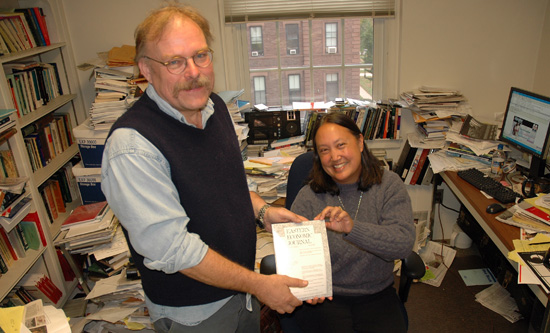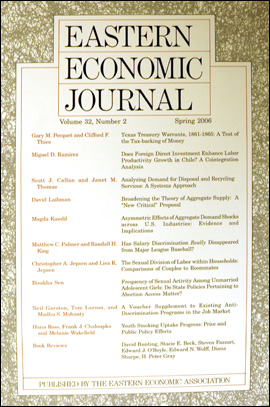Economics Professors Take on Role of Editors for National Journal
 |
| Gil Skillman, professor of economics and Joyce Jacobsen, the Andrews Professor of Economics are the co-editors of the Eastern Economics Journal. |
| Posted 11/01/06 |
| Two Wesleyan professors are devoted to making one of the countrys leading economic journals even better.
Joyce Jacobsen, the Andrews Professor of Economics and Gil Skillman, professor of economics, are the co-editors of the Eastern Economics Journal. Jacobsen and Skillman volunteered to assume editorship of thee publication in July 2005. They will complete their term in 2010. This is a rewarding opportunity as well as an important service to the profession, Skillman says. Helping authors turn a interesting but perhaps undeveloped ideas into solid contributions to the field can be very gratifying.
The editors seek advice from their 16-member editorial board, three associate editors, and get production assistance from managing editor Bill Boyd. Boyd is Jacobsens spouse. The journal considers manuscripts addressing a broad range of concerns including issues in economic methodology and philosophy as well as more standard contributions in economic theory and empirical economic analysis. The theoretical and empirical arguments in these papers are generally couched in formal mathematical terms, although submissions using less technical analytical methods are also accepted. Labor productivity growth in Chile, the demand for recycling services, salary in major league baseball, the sexual division of labor with households and anti-discrimination programs in the job market are all topics discussed in the journals most recent issue. “We are particularly interested in articles that have a neat idea that may be a little out of the mainstream of economics, that don’t fall neatly into a standard research category, and that other economists may find intriguing,” Jacobsen says. For instance, an upcoming issue will feature two articles debating about whether or not the penny should be dropped from our currency system. As new editors, Skillman and Jacobsen have several goals in mind. Their immediate goal is to publish a backlog of accepted manuscripts that were on hold prior to their editorship. Once they are caught up, they hope to become more selective with their manuscript selections. They are presently publishing about 25 percent of all submitted articles. Increased selectivity would help to raise the publications national profile. Jacobsen and Skillman also want to expand their subscription by finding a commercial printer than can offer advertising and publicity. Already, the association distributes the journal to 700 members and 300 libraries, nation-wide. They also want to expand the journals presence online. We believe that electronic publications are the wave of the future, Skillman says. Indeed, the journal already manages the editorial process online, as authors can submit their papers online, and referees file their reports online as well. In addition, Jacobsen and Skillman want to create special symposia issues, in which several articles tackle the same topic. Agent-based computer modeling of complex economic interactions is one potential focus area. When manuscripts are submitted, Jacobsen is the first to see them. She divvies up the submissions between herself and Skillman. Its fortunate Gil and I have varied specializations, she says. I handle the more empirical articles, and ones on feminist economics, and give Gil any manuscripts on micro theory, Marxist or institutional economics. The editors skim the papers to make sure they contain original work and do not have glaring errors of reasoning or methodology. If the paper passes this initial screening, they send the paper to two or three referees who are considered experts in that particular field of economics. Within a three-month period, the referees offer their feedback. If positive, then Jacobsen and Skillman will most likely eventually accept the manuscript for publication, although they generally recommend that the author first makes revisions. The editing and revising process can take up to 12 months. Once finalized, the manuscript goes into a queue and awaits publication space. We have a pretty steady stream of article submission and theres always lots of reading to do, but we dont mind, says Skillman. We get to learn a lot along the way. Wesleyan, which is credited on the journal, has been supportive of the editors’ efforts, giving them both financial resources for some of the journal’s overhead expenses and some course relief. The Eastern Economic Journal is online at http://www.iona.edu/eea/publications/publication.htm. |
| By Olivia Drake, The Wesleyan Connection editor |


 The Eastern Economics Journal, established by the Eastern Economic Association in 1973, publishes papers written from every perspective, in all areas of economics. The journal is published four times a year and features between eight and 10 articles per issue.
The Eastern Economics Journal, established by the Eastern Economic Association in 1973, publishes papers written from every perspective, in all areas of economics. The journal is published four times a year and features between eight and 10 articles per issue.